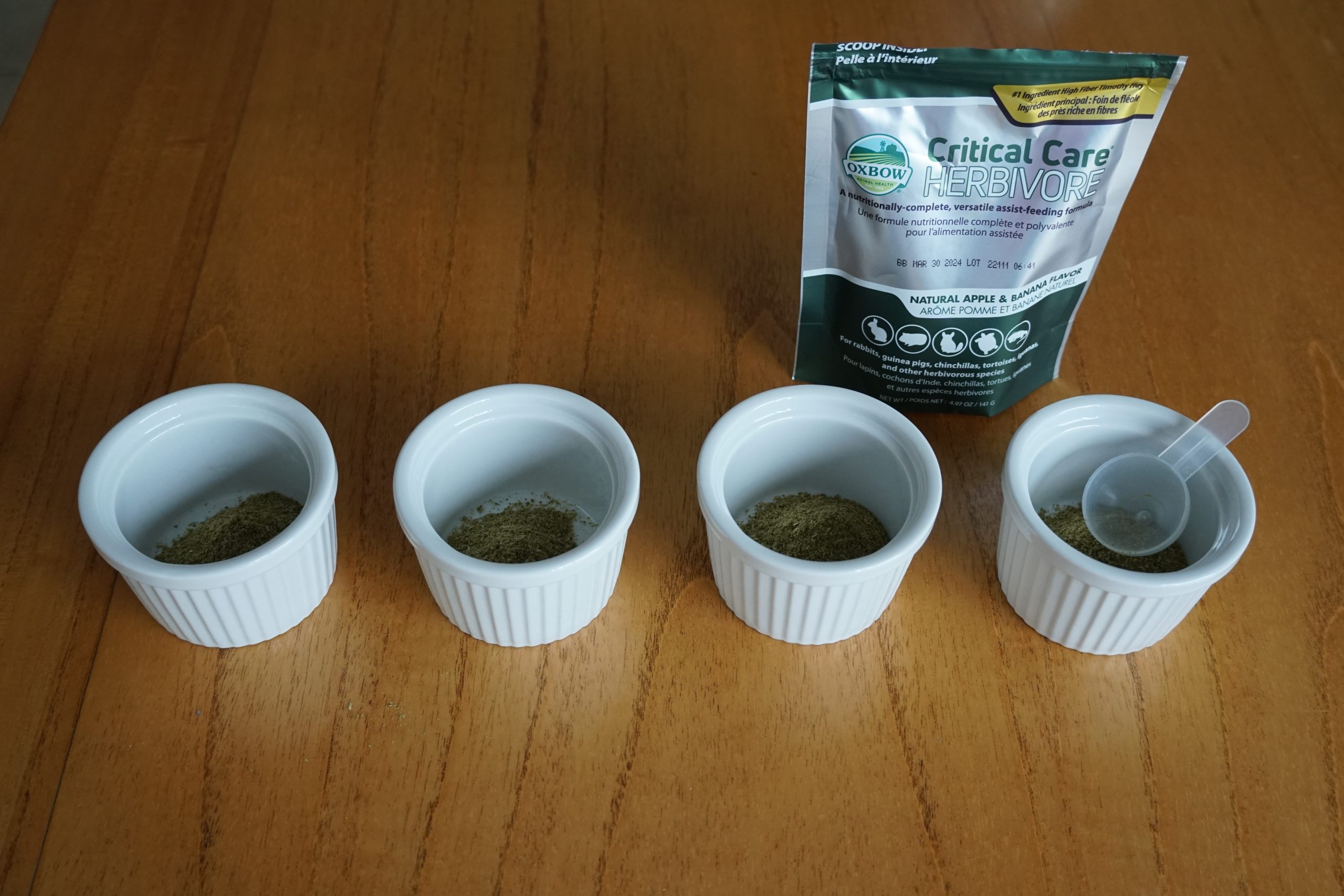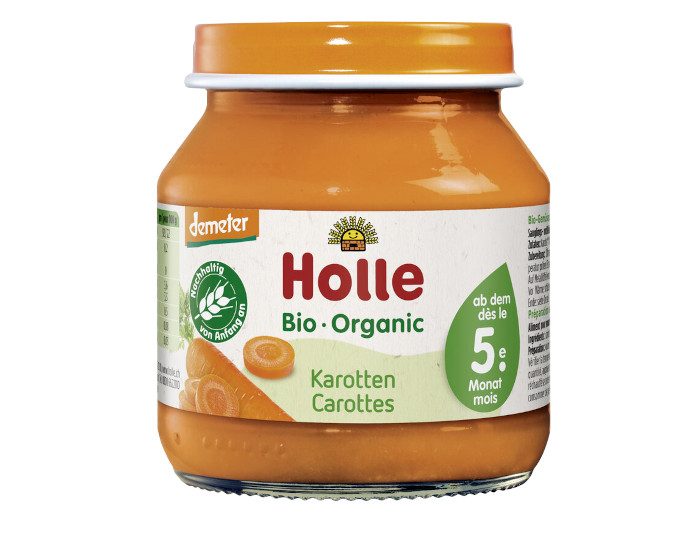When facing serious health issues, it is sometimes necessary to feed or force-feed your degu with specialized or convalescent nutrition. The most well-known option is Critical Care, which comes in powder form to be mixed with water and fulfills the fundamental needs of your degu when it is no longer able to feed itself. In some cases, feeding through the mouth may worsen the degu’s condition, especially during respiratory distress. In such situations, it is advisable to contact a veterinarian as soon as possible to place your degu on intravenous fluids.
Only a veterinarian familiar with degus can provide a proper diagnosis and suggest appropriate treatments. Be cautious not to self-diagnose your pets, as it can lead to a deterioration of their health.

When to Provide Medicated Food and Why?
During health problems or weight loss, it is essential to support your degu’s digestive system and ensure it continues to eat to stay hydrated and maintain its weight. While waiting for a veterinary consultation, you can offer convalescent food, either homemade or store-bought. In general, having syringes and the means to feed your degu in case of health problems is essential in your degu’s first-aid kit.
Convalescent foods can be used in cases of:
- Post-surgery feeding (after veterinary approval)
- Weight loss
- Refusal to eat/drink
- Dental issues
- Gastrointestinal problems
- Anorexia
- End-of-life care
These foods are often rich and provide the basic nutritional needs for herbivores, allowing them to recover more easily. Always consult your veterinarian if you suspect a health problem in your degu.
Medicated Food (Administered by a Veterinarian)
When a degu becomes seriously ill, it often stops eating by itself. During hospitalization, the veterinarian may choose to provide intravenous fluids to help the degu maintain its strength. However, due to the small size of a degu, using a nasogastric tube or an esophagostomy tube may be preferred to administer the necessary nutrition01. Enteral nutrition (by tube) also prevents health problems that prolonged anorexia can cause. For instance, the breakdown of tight junctions between gastric and intestinal cells can lead to bacterial overgrowth or even septicemia. Enteral nutrition can also prevent the risk of intestinal stasis.
Convalescent Nutrition
During a health problem that doesn’t require hospitalization or in cases of gastrointestinal stasis, it’s often necessary to feed your degu with convalescent food. These are liquefied foods that support your pet’s nutritional needs during recovery and prevent anorexia. It’s crucial to feed and hydrate a degu that refuses to eat, under veterinary guidance, to prevent gastrointestinal stasis or dehydration. Several options are available, but ready-made solutions are highly recommended to avoid nutritional imbalances. However, you can use homemade recipes temporarily until you obtain commercial convalescent products.
Commercial Convalescent Foods
EmerAid – Lafeber
EmerAid offers a range suitable for small herbivores like degus, chinchillas, and some reptiles. It can be easily purchased online. The calcium, phosphorus, and fiber levels are better suited to degus’ nutritional needs than other brands.
Ingredients: Cellulose, hydrolyzed soy protein, corn syrup, rice gel powder, inulin, corn oil, defatted wheat germ, canola oil, sucrose, glutamine, ground limestone, dicalcium phosphate, potassium bicarbonate, iodized salt, DL-methionine, magnesium sulfate, choline iodized salt, DL-methionine (an essential amino acid), magnesium sulfate, choline chloride, cysteine (an essential amino acid), vitamin A supplement, vitamin E supplement, menadione sodium bisulfite complex (a source of vitamin K), copper sulfate, manganese oxide, zinc oxide, niacin supplement, calcium pantothenate, riboflavin supplement, thiamine mononitrate, pyridoxine hydrochloride, vitamin B12 supplement, folic acid, biotin, ascorbic acid, tryptophane (an essential amino acid), manganese sulfate, ethoxyquin (preservative), zinc sulfate, sodium selenite.
Crude fiber (max): 35.7% Crude protein (min): 18.1% Crude fat (min): 9.0% Crude ash: 5.26% Moisture (max): 7.5%
Metabolizable energy (calculated): 1.32 kcal/ml 2.95 kcal/gram of dry weight
Omega-3 fatty acids (min): 0.37% Omega-6 fatty acids (min): 4.14% Calcium (min): 1.00% Phosphorus (min): 0.39% Sodium: 0.30% Lysine: 0.90% Methionine: 0.40%
Caloric distribution: Protein: 27.0% Fat: 33.2% Digestible carbohydrates: 39.6%
Fiber distribution: Non-fermentable/structural fibers: 75.3% Fermentable fibers: 24.7%

Critical Care – Oxbow
This is probably the most well-known product in Europe and is widely used for small herbivorous mammals. There are various types of Critical Care, and those meant for herbivores are suitable for degus.
Additives: Vitamin A: 12,000 IU/kg Vitamin D3: 900 IU/kg Vitamin E: 190 IU/kg Vitamin C: 10,000 mg/kg Iron (ferrous sulfate, monohydrate): 50 mg/kg Iodine (calcium iodate, anhydrous): 2.3 mg/kg Cobalt (cobalt carbonate, basic monohydrate): 2 mg/kg Manganese (manganese chelate of amino acids, hydrated): 2 mg/kg Manganese (manganese oxide): 8 mg/kg Copper (copper sulfate pentahydrate): 10 mg/kg Copper (copper chelate of amino acids, hydrated): 2 mg/kg Zinc (zinc sulfate, monohydrate): 66 mg/kg Zinc (zinc chelate of amino acids, hydrated): 33 mg/kg Selenium (sodium selenite): 0.22 mg/kg Inactivated selenium-enriched yeast: 0.08 mg/kg
Analytical constituents: Crude protein: 16.0% Crude fat: 3.0% Crude fiber: 23.5% Crude ash: 10.0% Calcium: 0.5% Phosphorus: 0.3%
Supreme Petfood – Science Selective Recovery
Supreme Petfood offers pre-packaged convalescent food with liquid food sachets and a syringe. The fiber content is slightly below the degu’s needs, but this food can be used for short-term situations.
Additives: Vitamin A: 12,000 IU Vitamin C: 10 IU Vitamin D3: 1,500 IU Iron (ferrous sulfate monohydrate): 28 mg Iodine (calcium iodate): 2.3 mg Copper (copper sulfate pentahydrate): 19 mg Manganese (chelate of manganese amino acids, hydrated): 2 mg Manganese (manganese oxide): 115 mg Zinc (zinc sulfate, monohydrate): 70 mg Selenium (sodium selenite): 0.28 mg
Analytical constituents: Crude protein (min): 15.0% Crude fat (min): 1.0% Crude fiber (min): 16.0% Crude fiber (max): 22.0% Moisture (max): 11.0% Calcium (min): 0.6% Calcium (max): 1.2% Phosphorus (min): 0.2% Vitamin A (min): 6,000 IU/kg Vitamin D3: 1,000 IU/kg Vitamin E (min): 60 IU/kg.
Rodicare – Fendigo
Rodicare and Rodicare Instant are a range of convalescent foods for small mammals, but their fiber and calcium levels are very low for degus’ needs. This product can be used for short-term situations but should be avoided in the long run.
Ingredients: Alpine grass meal 30%, soybean hull 25%, flax seeds, oat bran 10%, wheat germ, fennel 1.5%, rapeseed oil, mint 1%, cumin 1%, pectin 1%, sodium chloride, fenugreek 0.5%, licorice 0.5%, turmeric 0.5%, calamus root 0.5%, chamomile 0.5%, fructo-oligosaccharide 0.25%.
Analytical constituents: Crude ash: 6.9% Crude fat: 4.8% Calcium: 0.5% Crude protein: 16% Crude fiber: 22%
Nutritional additives: Vitamin A: 11,400 IU Vitamin D3: 760 IU Vitamin E: 38 mg Vitamin C: 9510 mg Vitamin K3: 1.9 mg Vitamin B1: 1.4 mg Vitamin B2: 3.8 mg Vitamin B6: 3.8 mg Vitamin B12: 28.5 µg Vitamin B3: 19 mg Calcium pantothenate: 12.8 mg Choline chloride: 285 mg Iron sulfate: 47.5 mg Manganese oxide: 38 mg Zinc oxide: 57 mg Copper sulfate: 11.9 mg Calcium iodate: 0.9 mg Sodium selenite: 0.2 mg Cobalt: 0.4 mg.
You can enhance the convalescent food by adding hazelnut powder or a bit of apple juice to make it more palatable if necessary.
Homemade Recipes
In case of emergencies, you can offer alternative solutions to store-bought products to your degu until you can obtain them. There are several methods for feeding or hydrating a degu that refuses to eat. These methods should be used for a short time only to avoid nutritional imbalances and deficiencies in the rodent.

Infusions/Flavored Water
To encourage your degu to rehydrate, you can offer them cold infusions made from dried herbs, such as those found in the SAB Degu mix: dandelion, nettle, linden, chamomile, etc. The altered taste may encourage your degu to rehydrate on its own.
You can also flavor the water with a small amount of fruit juice, well-diluted. Degus have a slow insulin-regulating metabolism, so it’s important to avoid adding too many carbohydrates in the long term.
Granule Mash
To feed your degu, you can offer a mash made from soaking granules in water for a few hours. It’s a good idea to blend the granules to create a smoother mixture. If the mixture is not appetizing enough, you can add a bit of fruit juice or hazelnut powder. This method is not ideal because most granules do not create a homogeneous and easy-to-administer mixture with a syringe. However, it can serve as a temporary solution in emergencies.
Baby Food/Vegetable Puree
As a last resort, if your degu refuses to eat anything, you can offer them vegetable puree (such as carrots, beans, etc.). Choose leafy vegetables like spinach or low-carb vegetables. Another option is to offer vegan baby food without added carbohydrates. All ingredients should be non-toxic to your degu.
This last solution should only be used occasionally in emergencies and as a last resort.

Force-Feeding Your Degu
When your degu refuses to eat and drink, it’s essential to provide various solutions to encourage eating. Ultimately, you may need to use the “burrito” method02 to force-feed them with a syringe. However, this procedure can be very stressful for both the owner and the degu, so we recommend leaving convalescent food available in a dish as the first option.
Note that when dealing with respiratory problems, force-feeding must be done with great caution to prevent choking. You can use a very liquid food in smaller quantities or provide it under supervision. Always consult your veterinarian for advice on feeding in cases of respiratory issues.
Quantity to Administer/How to Feed Convalescent Food to a Degu
A degus drinks between 10ml and 30ml of water per day, depending on its environment and diet03 04. Degus should be fed through gavage at least 5 times a day, dividing the meals (2 to 5ml per meal), and if there is no risk, you can leave food available in a low bowl (e.g., a ceramic dish) in the cage. Always provide fresh water and hay, in addition to the recovery diet (unless there is a veterinary contraindication).
For degus that eat recovery food on their own, gavage is not necessary. Consider separating your degu from its companions during meal times if food is left available to allow it to eat properly. If that’s not possible, set up multiple well-filled bowls to make it easy for your degu to access the food.
Using a syringe
If your degu refuses to eat the offered food on its own, you will need to use a syringe without a needle to gavage it. Some brands provide these in their recovery food boxes. Different types of syringes are available, but for degus, fine-dosing syringes without needles are recommended. Your degu will only need a few milliliters per feeding, so there’s no need for large syringes. The syringes should be properly cleaned between each use.
Depending on the condition and capabilities of your degu, adjust the fluidity of the mixture by adding water. The more fluid the mixture, the easier it will be to swallow. Gently squeeze the syringe as you feed and take 30-second breaks to allow the animal to breathe05. If gavage is necessary, you can gently introduce the tip of the syringe at the side of the mouth to avoid the incisors. This will make the degu less likely to bite the syringe, facilitating the administration of the mixture. Keep the animal in as natural a position as possible to prevent the risk of choking06. For example, do not feed a degu on its back.
How to hold your degu
Depending on the foods offered and the character of the degu, some animals will eat from the syringe themselves. When this is not the case, it is essential to hold the degu properly during feeding. To do this, we recommend using the “burrito” method.02.

The “burrito” method is a technique for containing a degu during feeding. To apply this method correctly, please follow the steps in our article on degu handling.
Sources
- Ferrets, Rabbits, and Rodents, Clinical Medicine and Surgery[↩]
- Burrito technique – Degumania[↩][↩][↩]
- Comparative water economy of sympatric rodents in a Chilean semi-arid habitat[↩]
- Diet and Feeding – Degutopia[↩]
- How to provide nutrition to rabbits in the critical care setting[↩]
- CRITICAL CARE TIPS AND TRICKS[↩]


